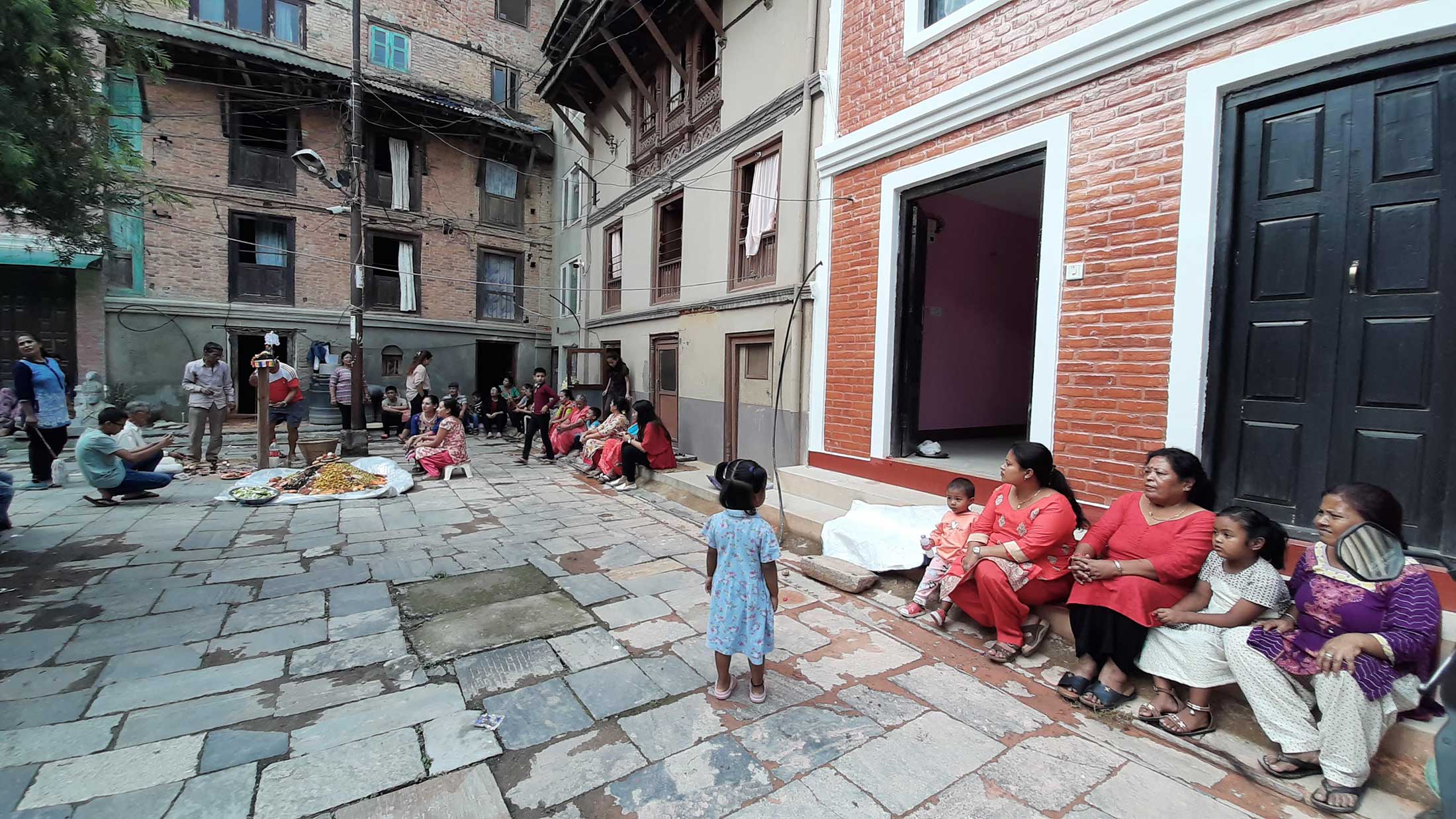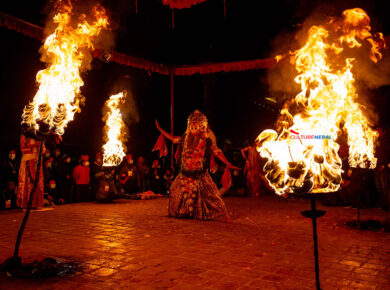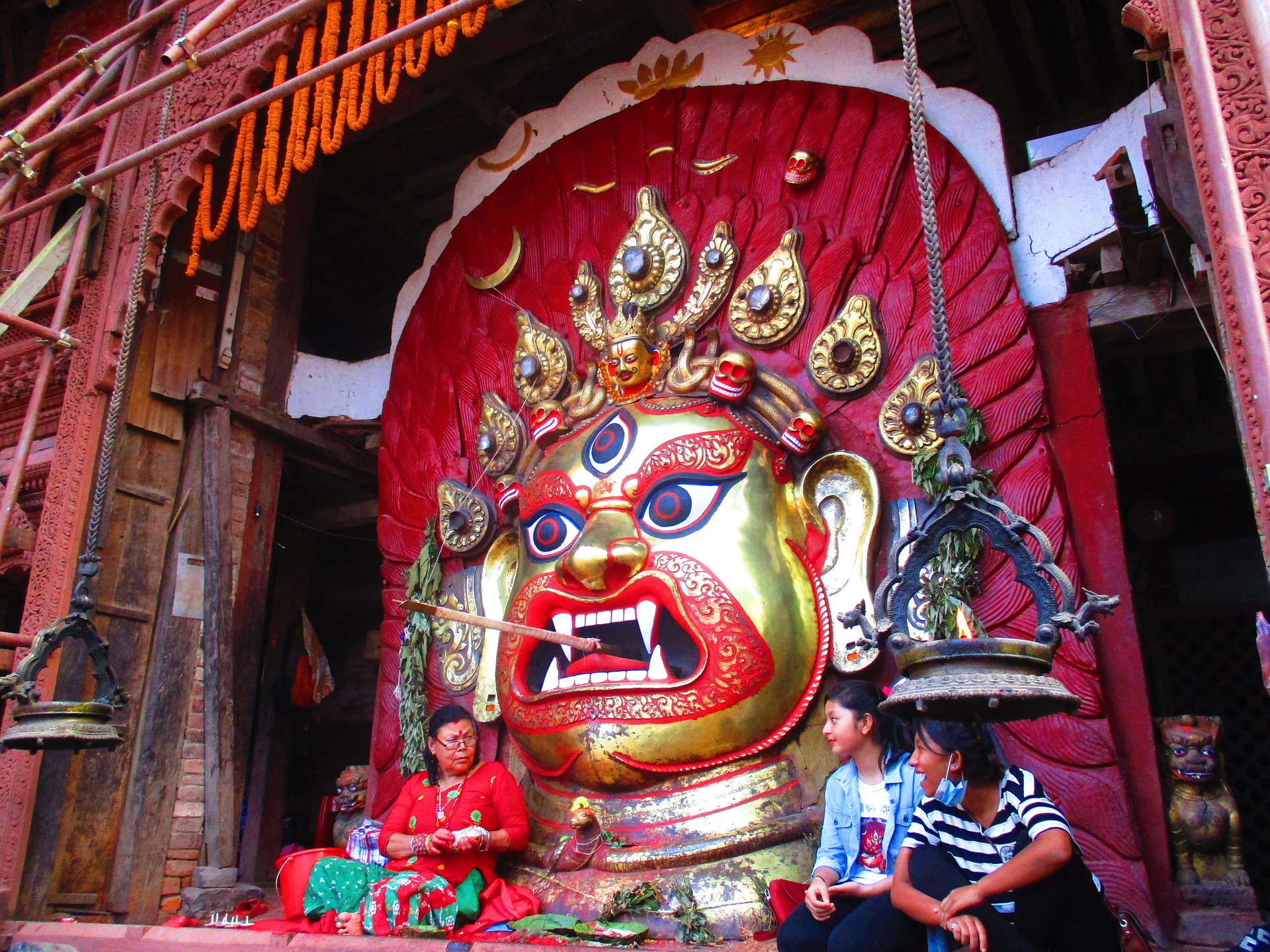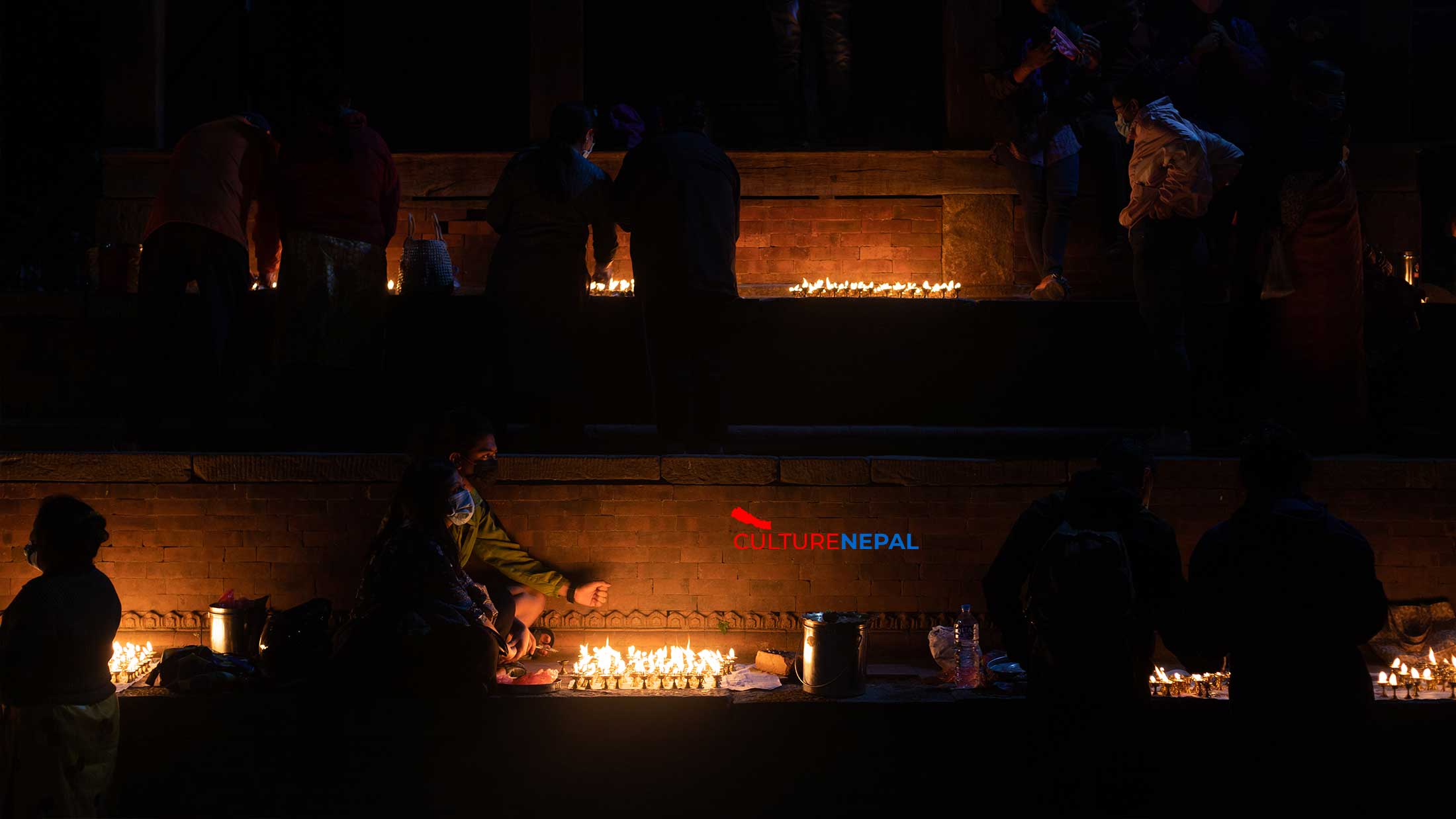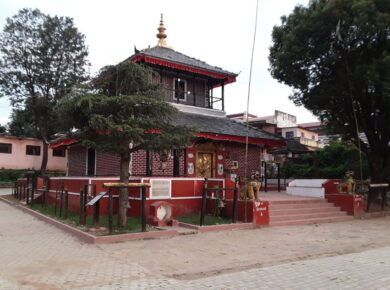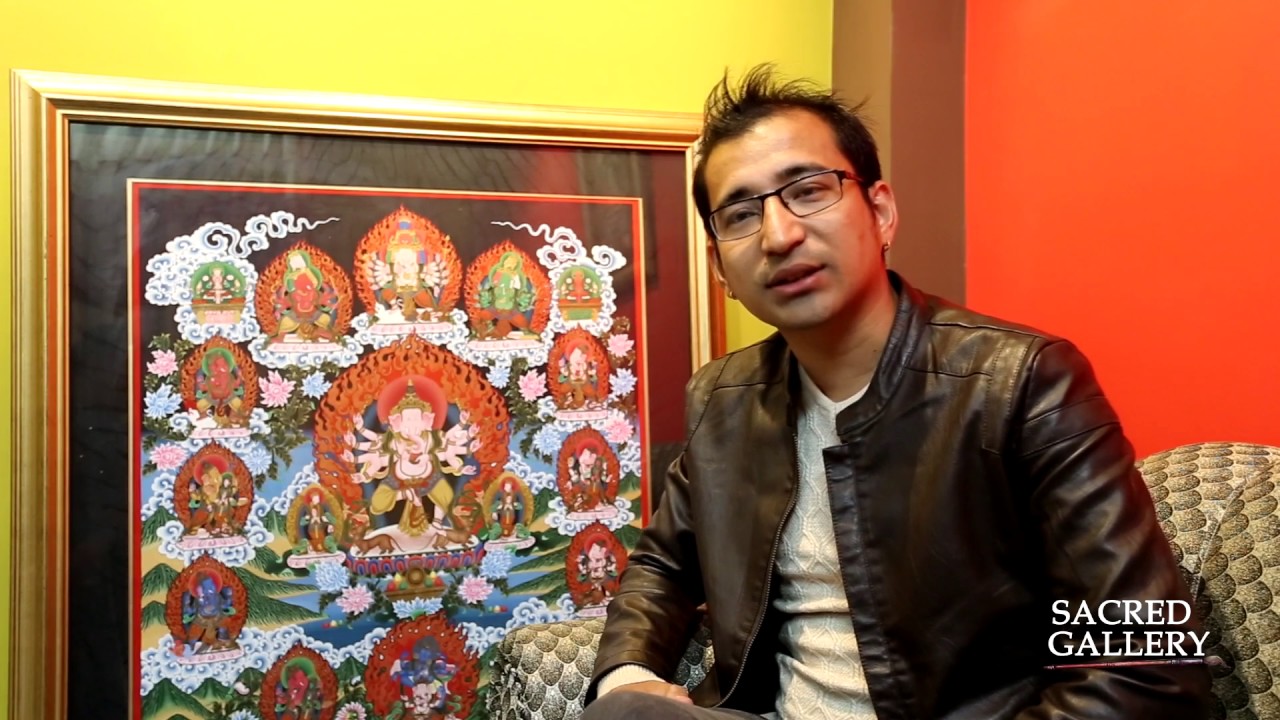Kathmandu is famous for many types of festive celebrations and the Indrajatra is one of the most important among them because of its antiquity and its continuation only in Nepal.
On the Bhadra Shukla Dwadashi day ( e. Sept, 20, 1901 ) a 48 feet high wooden pole of Saila tree (pine tree) is established infront of the Kala Bhairava image at the Durbar Square of Kathmandu and follows the Indrajatra festival. The Indra-Dhvoja or Indra’s flag-staff is thken to represent Lord Indra himself. The Lord is believed to live in the heaven and therefore the staff is made as high as possible.
A long banner painted with d sacred symbols and signs hangs tall wooden flag-staff.
The wooden Pole is broughl Chu likhel (Nala ? ) by the Mar caste Newars, who are entruste, this task since old times. While cutting the Pole a goat is sacrificed to the tree and brought to Kathmandu ceremonial accompanied by some government officials.
Lord Indra is honoured and ped during the Inclrajatra by plac images in different places of .t Similarly, wooden images of Bhair other deities are also displayed pavements of the .city to present ti as an open exhibition. Important is the Akash Bhairava of Indrachok which is specially displayed outside his temple. Another image of the Bhairav or the ferocious god of the sky, which is depicted in the form of a head, is seen at the Durbar square area. A special week-long worship is also offered to this deity.
Picture of Akasha Bhairava
Caption: the deity Akasha Bhairava at Hanumandhoka Square. He is famous for drinking huge amount of beer.
The original custom of worshipping Lord Indra is visible during the Indrajatra festival. A small gold image of Indra is placed at the foot of the wooden Pole and is worshipped. Several wooden images of the Lord are also displayed on the pavements of the city during this occasion.
The custom of installation of a long Pole on the fixed spot at the Hanuman-dhoka Durban square is said in the genealogy to have instituted by King Pratapa Simha Shah ( 1775-1778 ) at first at Nuwakot and later in Kathmandu. A stone inscription recovered from Nuwakot dated 1763 and issued by the Crown Prince Pratapa Sinha Shah records a land grant made by the latter to celebrate the Indrajatra at Nuwakot( Vajrasharya, Shrestha 2032,28-29 AP. ). This reference confirms that the then crown Prince Pratapa Simha Shah had instituted an Indrajatra at Nuwakot five years before the occupation of Kathmandu. After the occupation of the same the festival seems to have been shifted to Kathmandu.
INDRAJATRA A court Pandit of the time named Shaktivallabh had compiled a work on the Indraj atra entitled INDRA.-DHVAJOT-SAVA, most probably by royal orders.
The festival related to Lord Indra might have its origin in Vedic times as its name suggests.
In the Rigveda Ind.ra certainly over-shadows other gods and. hence he is addre-ssed in 114 of the hymns contained in that oldest literature of the Aryans. The impressive personality of Indra can be known from the following quotation from Rigveda:-
“Indra is the monarch
of all tivt move and rest,
The thunder-wielder is monarch
of tame and horned animals:
He indeed is ruler of all the people
like a felly round. the spokes of a wheel
he protects all”.
The divine King is also associated with the prosperity as hinted. in one of the Rigvedic hymns as such:-
“Illustrious far and wide, may Indra prosper us …..”
Indra has also been described in the Rigveda as a favourite national god and has many mythologies woven around him. He has been described there as bearing vajra thunderbolt ), hook, the bow and arrows as allowed by his martial personality and responsibility. He is also described as the releaser of water, generous to his worshippers and a heavy Soma-drinker. In such a background it seems probable that the Indra-Jatra was celebrared by the Aryans of the Vedic times though it is not mentiened in the vedas or the Brahmana texts.
The Epic and the Puranic sources mention legends relating to the origin of the Indra-Matra and prove the popularity of the festival during these times.
A legend contained in the epic Maha-bharata may be the first reference to the Indra’s flag-staff and its relation to kingship and royal duties. The legend first mentions a religious king named Uparichara. Lord Indra gave him a bamboo staff to please him and to protect good citizens. After the lapse of one year the king installed that staff on the ground to worship lord Indra. After that event great Kings follo-wed that custom continuously. How to decorate the Indra’s staff and worship it is also described there and the result of all this has been described. as having good effects to the protection of the country. The sixth century A. D. astrologer Vara-hamihira also describes the lndra—cl.hvaja and.rams staff or fag) in a separate chap-ter and relates its origin to King Upari-chara Vasu as described in the said epic but with a slight difference in particulars. According to Varahamihira lord indra granted a bamboo staff to Uparichara Vasu. the King of chedi Kingdom. The King worshipped. that staff according to the prescribed rules.
The ritual made the Lord Indra very pleased and propheced that those Kings who worship like this will be prosperous
and able rulers like Uparichara Vasu.
Vishnudharmottara Purana contains another legend. regarding the origin of the Indra’s flag—staff. The legend begins with the event of the defeat of the gods by the Asuras ( demons ). Defeated gods reported to Lord Vishnu led by Indra. On learnling god’ s grievances, Vishnu offered Ind.ra a flag—staff to lead it while engaged in the battle against the Asuras. Being assured thus by Vishnu Indra led the army of gods to invade upon the Asuras leading the flag—staff. Through the mysterious effects of the divine flag—staff the gods became victorious over the Asuras, and they worshipped the same enthusiastically . After worshipping the staff, Lord Indra gave the fiagstgc to King Vasu of Chedi country and told. that those Kings who celebrate Ind.ra.,-Dhvaja, would prosper variously and in addition the Kingdom would have no fear from enemies.
After accepting the staff, King Vasu worshipped and honoured it muct and he became prosperous and victorious.
It is also alleged that Lord Vishnu had ordered the gods including Indra to fight the demons carrying a flag having emblems of the sun and the moon. When the Gods became victorious they started this Indrayatra in memory of such an important event.
Some literary Samskrit works of different times also mention the merits of Indra-Dhvaja. The first century poet Ashvaghosha and the fourth century poet Kalidasa have mentioned the same and help us to prove its continued popularity during the hist-orical periods.
The Puranas and the Agamic-Tantrik literature have also given much importance to the Indrajatra festival. Accordingly, the installation of the flag-staff of the Lord Indra and worshipping the deity, his wife Indrani and their son Jayanta, brings riches. On the Bhadra Shukla Dwadashi day the installation of the flag-staff is to be made, then on the 14th day of the same quarter the divinities are to be specially worshipped. On the 15th day of the quarter the celebrations come to an end (Rana 2020: 264-65).
Such legends apparently helped to propagate the cult of Indra-Dhvaj and the festive ceremony related to it among the Aryan Kings of ancient and medieval Nepal and India.
Two inscriptions of the Licchavi Period probably suggest the existence of the Indrajatra in an unspecified reference. An official stone inscription from Lele dated 604 makes mention of ‘a committee for Indra’ (Indragosthi) and its landed property (Vajracharya 2030: 283). Another official stome inscription from Lalitpur dated 713 al so refers to a similar instance (Vajrach-arya 2030: 540). These two are taken as indirect references to the existence of the Indrajatra in the ancient period (Vajra-charya 2033: 172) although we are unable to know the particulars related to that festival during that period.
Some stray references tend to suggest the countinuity of the Indrajatra during the medieval period. A genealogical work of late period describes that the Vaishya Thakuri Kings of Kathmandu had added the Manji Pat-demon dance to the Indrajatra in circa 1140 (Lamsal 2023: 29). Another genealog-ical work entitled the Gopala Varnshavali also refers to a. clear inference of Indrajatra for the year 1379 (Vijracharya, Malla 1985: 132).
Baburam Acharya thinks that this festi-val was celebrated enthusiastically during the 17th century (Acharya 2016:19). This statement is supported by one inscription of King Pratapalla inscribed in the pedestal of a bronze image of Vishvarupa (Vajracharya 2023:173 217-18). The inscri-ption mentions that the image should be exhibited during Indrajatra and Saddharma j atra (Bahi-boya festival of the’ Buddhists), The inscription is dated for 1697.
We have at our disposal two other short references to the Indrajatra for the late Maila period. In a contemporary diary (Thyasaphu) it is referred to for the date 1676 (Regmi 1966:333). Another reference
to it is found in an inscription dated 1688 (ibid. 216).
Jaya Prakash walla, the last Malla King of Kathmandu had added the Kumari Yatra in 1753 into the traditional Indra-jatra festival and had built a house for the goddess in 1757 near the Royal Palace Vajracharya 2033: 42- 3,173 ).
During the Malla Period the Indra’s staff was used to be installed at the Atkonarayan temple at Chikanmugal tol. The tradition siall continues.
